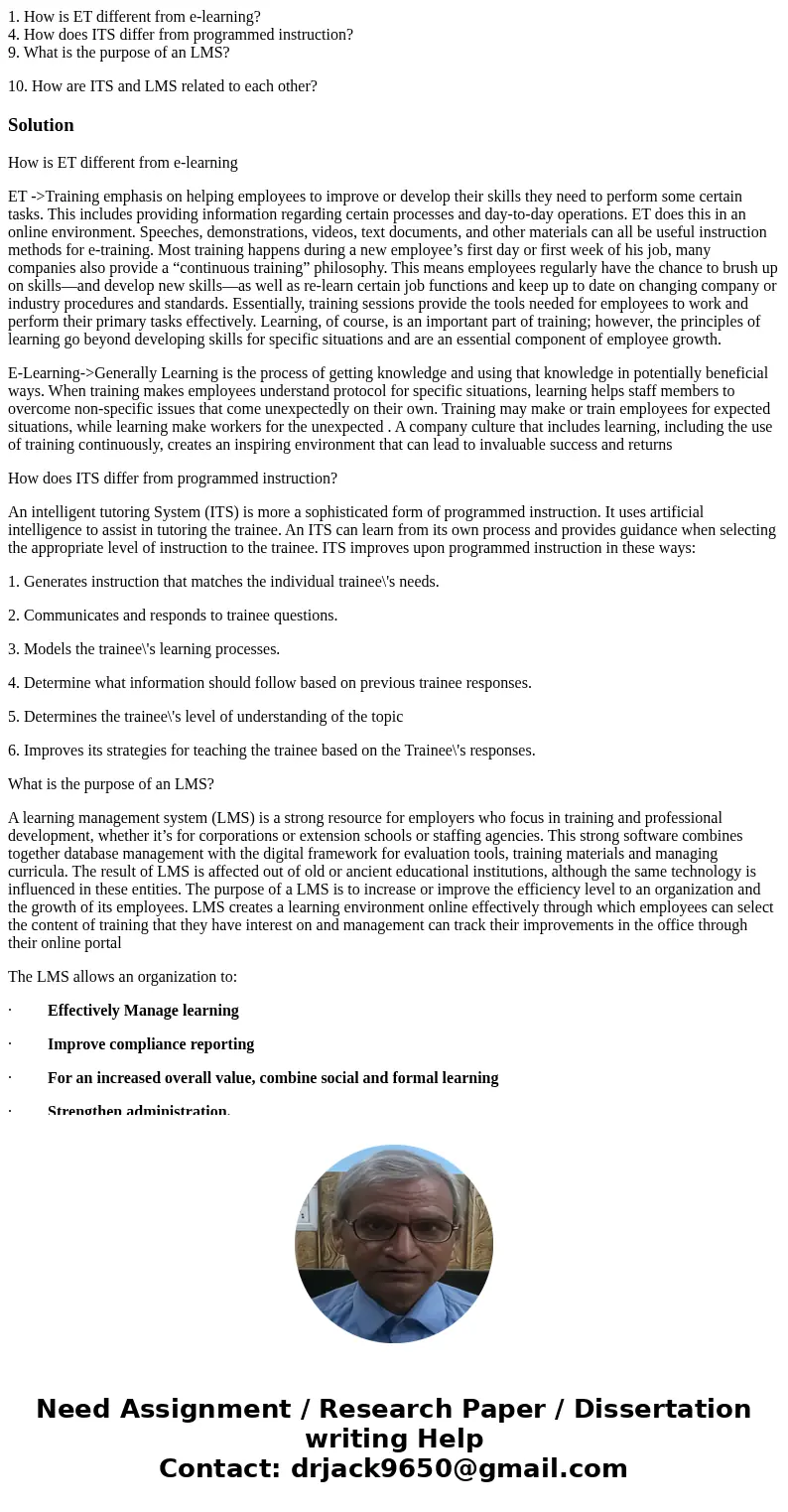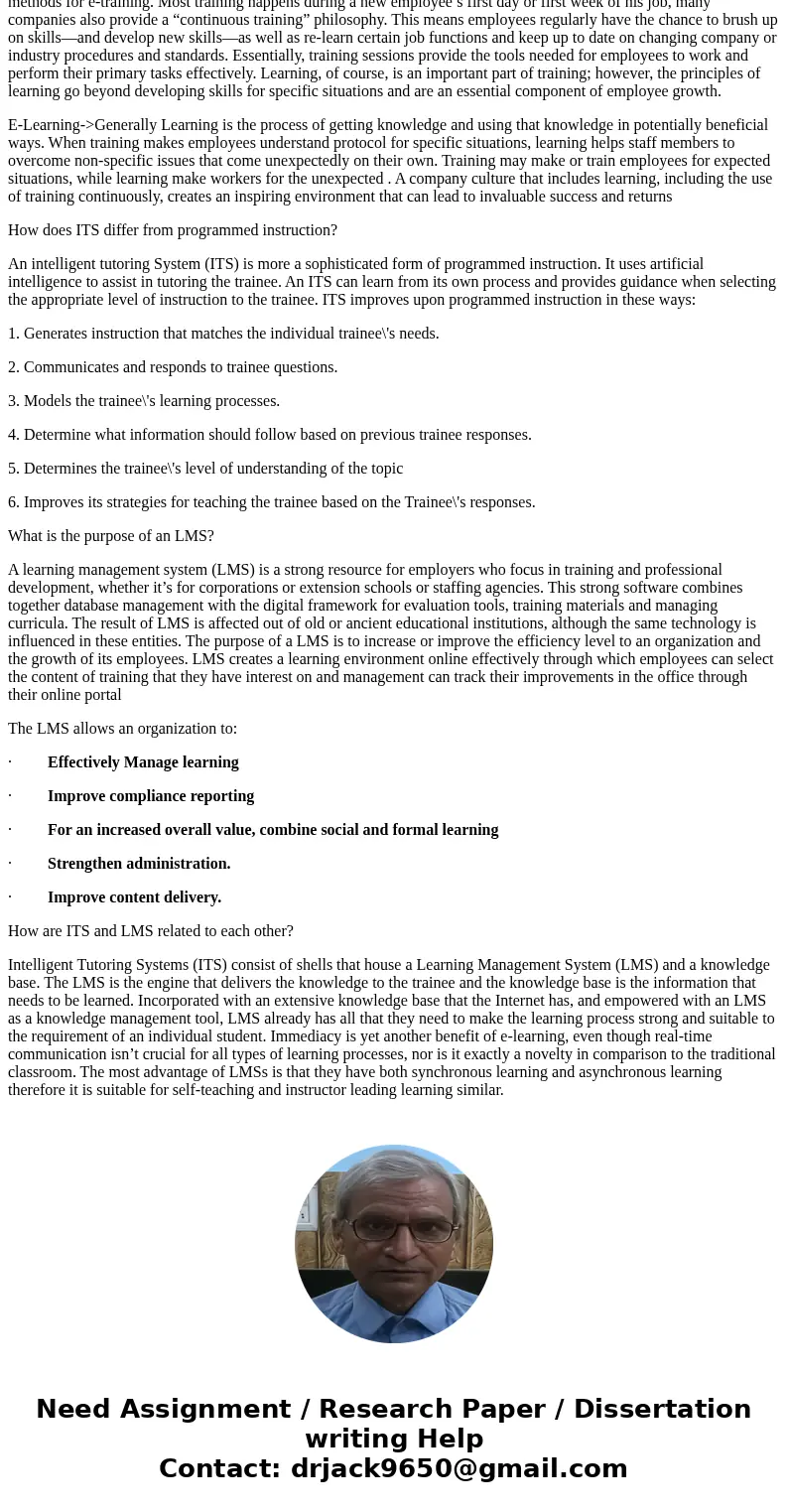1 How is ET different from elearning 4 How does ITS differ f
1. How is ET different from e-learning?
4. How does ITS differ from programmed instruction?
9. What is the purpose of an LMS?
10. How are ITS and LMS related to each other?
Solution
How is ET different from e-learning
ET ->Training emphasis on helping employees to improve or develop their skills they need to perform some certain tasks. This includes providing information regarding certain processes and day-to-day operations. ET does this in an online environment. Speeches, demonstrations, videos, text documents, and other materials can all be useful instruction methods for e-training. Most training happens during a new employee’s first day or first week of his job, many companies also provide a “continuous training” philosophy. This means employees regularly have the chance to brush up on skills—and develop new skills—as well as re-learn certain job functions and keep up to date on changing company or industry procedures and standards. Essentially, training sessions provide the tools needed for employees to work and perform their primary tasks effectively. Learning, of course, is an important part of training; however, the principles of learning go beyond developing skills for specific situations and are an essential component of employee growth.
E-Learning->Generally Learning is the process of getting knowledge and using that knowledge in potentially beneficial ways. When training makes employees understand protocol for specific situations, learning helps staff members to overcome non-specific issues that come unexpectedly on their own. Training may make or train employees for expected situations, while learning make workers for the unexpected . A company culture that includes learning, including the use of training continuously, creates an inspiring environment that can lead to invaluable success and returns
How does ITS differ from programmed instruction?
An intelligent tutoring System (ITS) is more a sophisticated form of programmed instruction. It uses artificial intelligence to assist in tutoring the trainee. An ITS can learn from its own process and provides guidance when selecting the appropriate level of instruction to the trainee. ITS improves upon programmed instruction in these ways:
1. Generates instruction that matches the individual trainee\'s needs.
2. Communicates and responds to trainee questions.
3. Models the trainee\'s learning processes.
4. Determine what information should follow based on previous trainee responses.
5. Determines the trainee\'s level of understanding of the topic
6. Improves its strategies for teaching the trainee based on the Trainee\'s responses.
What is the purpose of an LMS?
A learning management system (LMS) is a strong resource for employers who focus in training and professional development, whether it’s for corporations or extension schools or staffing agencies. This strong software combines together database management with the digital framework for evaluation tools, training materials and managing curricula. The result of LMS is affected out of old or ancient educational institutions, although the same technology is influenced in these entities. The purpose of a LMS is to increase or improve the efficiency level to an organization and the growth of its employees. LMS creates a learning environment online effectively through which employees can select the content of training that they have interest on and management can track their improvements in the office through their online portal
The LMS allows an organization to:
· Effectively Manage learning
· Improve compliance reporting
· For an increased overall value, combine social and formal learning
· Strengthen administration.
· Improve content delivery.
How are ITS and LMS related to each other?
Intelligent Tutoring Systems (ITS) consist of shells that house a Learning Management System (LMS) and a knowledge base. The LMS is the engine that delivers the knowledge to the trainee and the knowledge base is the information that needs to be learned. Incorporated with an extensive knowledge base that the Internet has, and empowered with an LMS as a knowledge management tool, LMS already has all that they need to make the learning process strong and suitable to the requirement of an individual student. Immediacy is yet another benefit of e-learning, even though real-time communication isn’t crucial for all types of learning processes, nor is it exactly a novelty in comparison to the traditional classroom. The most advantage of LMSs is that they have both synchronous learning and asynchronous learning therefore it is suitable for self-teaching and instructor leading learning similar.


 Homework Sourse
Homework Sourse